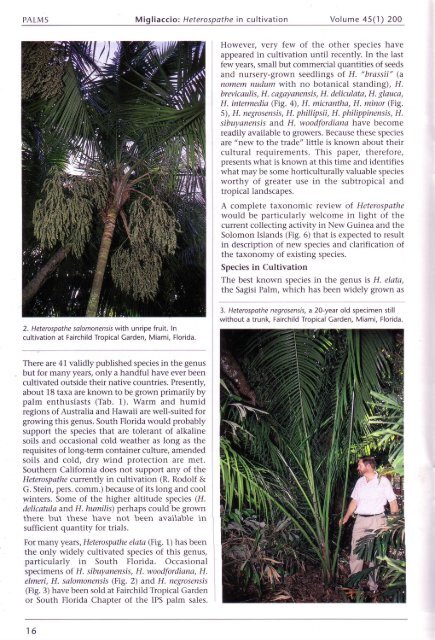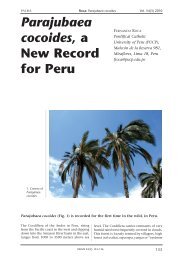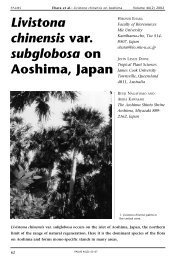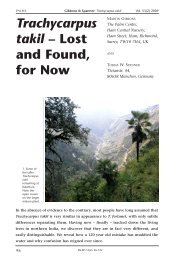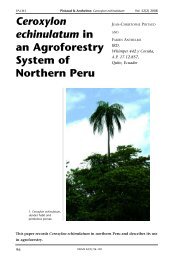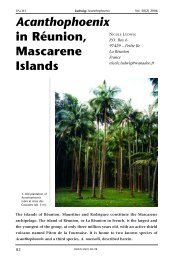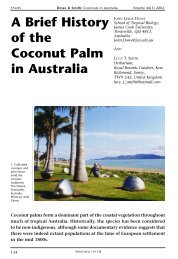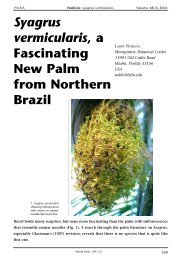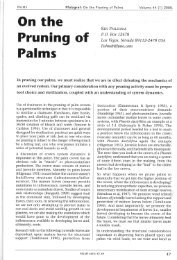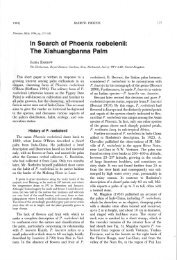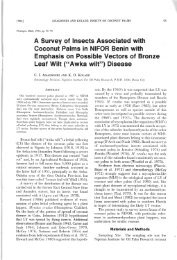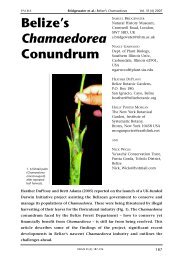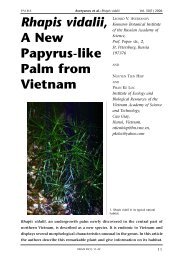The Genus Heterospsthe in Cultivation - International Palm Society
The Genus Heterospsthe in Cultivation - International Palm Society
The Genus Heterospsthe in Cultivation - International Palm Society
You also want an ePaper? Increase the reach of your titles
YUMPU automatically turns print PDFs into web optimized ePapers that Google loves.
PALMS<br />
Migf iaccio: Heterospothe <strong>in</strong> cultivation<br />
Volume 45(1) 2O0<br />
However, very few of the other species have<br />
appeared <strong>in</strong> cultivation until recently. In the last<br />
few years, small but commercial quantities of seeds<br />
and nursery-grown seedl<strong>in</strong>gs of H. "brassii" (a<br />
nomem nudum with no botanical stand<strong>in</strong>g), H.<br />
brevicaulis, H. cagayanensis, H. deliculata, H. glauca,<br />
H. <strong>in</strong>termedia (Fig. 4), H. micrantha, H. m<strong>in</strong>or (Fig.<br />
5), H. negrosensis, H. phillipsii, H. philipp<strong>in</strong>ensis, H.<br />
sibuyanensis and H. woodfordiana have become<br />
readily available to growers. Because these species<br />
are "new to the trade" little is known about their<br />
cultural requirements. This paper, therefore,<br />
presents what is known at this time and identifies<br />
what may be some horticulturally valuable species<br />
worthy of greater use <strong>in</strong> the subtropical and<br />
tropical landscapes.<br />
A complete taxonomic review of Heterospathe<br />
would be particularly welcome <strong>in</strong> light of the<br />
current collect<strong>in</strong>g activity <strong>in</strong> New Gu<strong>in</strong>ea and the<br />
Solomon Islands (Fig. 6) that is expected to result<br />
<strong>in</strong> description of new species and clarification of<br />
the taxonomy of exist<strong>in</strong>g species.<br />
Species <strong>in</strong> <strong>Cultivation</strong><br />
<strong>The</strong> best known species <strong>in</strong> the genus is H. elata,<br />
the Sagisi <strong>Palm</strong>, which has been widely grown as<br />
2. Heterospothe solomonensis with unripe fruit. In<br />
cultivation<br />
Fairchild Tropical Garden, Miami, Florida.<br />
3. Heterospathe negrosensis, a 2o-year old specimen still<br />
without a trunk, Fairchild Tropical Carden, Miami, Florida<br />
<strong>The</strong>re are 41 validly published species <strong>in</strong> the genus<br />
but for many years, only a handful have ever been<br />
cultivated outside their native countries. Presently,<br />
about 18 taxa are known to be grown primarily by<br />
palm enthusiasts (Tab. 1). Warm and humid<br />
regions of Australia and Hawaii are well-suited for<br />
grow<strong>in</strong>g this genus. South Florida would probably<br />
support the species that are tolerant of alkal<strong>in</strong>e<br />
soils and occasional cold weather as long as the<br />
requisites of long-term conta<strong>in</strong>er culture, amended<br />
soils and cold, dry w<strong>in</strong>d protection are met.<br />
Southern California does not support any of the<br />
Heterospathe currently <strong>in</strong> cultivation (R. Rodolf &<br />
G. Ste<strong>in</strong>, pers. comm.) because of its long and cool<br />
w<strong>in</strong>ters. Some of the higher altitude species (J'I.<br />
delicatulq and H. humilis) perhaps could be grown<br />
there but these have not been available <strong>in</strong><br />
sufficient quantity for trials.<br />
For many years, Heterospathelata (Fig. 1-) has been<br />
the only widely cultivated species of this genusr<br />
particularly <strong>in</strong> South Florida. Occasional<br />
specimens of H. sibuyanensis, H. woodfordiana, H.<br />
elmeri, H. salomonensls (Fig. 2) and H. negrosensis<br />
(Fig. 3) have been sold at Fairchild Tropical Garden<br />
or South Florida Chapter of the IPS palm sales.<br />
16


